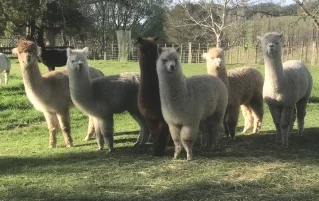An Introduction to Alpacas
The Basics
- Alpacas and llamas belong to the camel family.
- Camels evolved into many forms in North America and eventually spread across the Americas and Asia. Only five species remain.
- Llamas and alpacas come from South America and are the domesticated forms of the guanaco and vicuña respectively.
- An alpaca will weigh about 70 kg and average 90 cm at the withers.
- A llama is heavier, averaging 170 kg and be 110 cm at the withers.
- Llamas have inwardly curving ears whereas the alpaca's are straight.
- Male alpacas are called machos, females are called hembra and their young are called cria.
- There are two types of alpaca, the teddy bear-like huacaya, and the suri which has a dreadlock-style of fleece.
- The lifespan of an alpaca is around 20 years.
- Alpacas produce fibre that is very soft, warm and strong. It contains very little lanolin.
- Sixteen fibre colours are recognised in New Zealand, ranging from white through to many fawn and brown shades to true black, plus six grey shades.
- Alpacas are environmentally friendly. They have two pads on each foot (not hooves) which allows them to graze paddocks without damaging them.
- Pregnancy averages eleven and a half months and a single cria is born weighing around 8 kg.
- After birth, the cria will be standing and suckling inside two hours.
- Alpacas are intelligent, gentle and social animals. They must live in groups of at least two.
- Alpacas use a wide variety of sounds and body language to communicate information to each other.
- Four to five alpacas can be raised per acre of land (0.7 stock units each).
Further more detailed information can be found in these subject areas.
Quick Page Links
